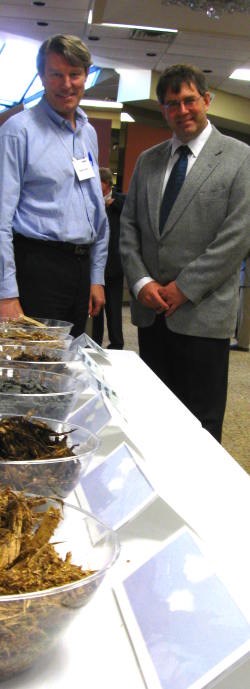The hot topic at the Marconi Hall yesterday was steam - all the steam needed to generate 35 megawatts of electricity.
St. Marys Renewable Energy Corp. President Gord Acton and Manager of External Affairs Marc Dube (both shown) were there to dish all the steamy details about their heat and power project proposal at an open house.
The renewable energy project would feed unmarketable wood fibre from forest harvesting and processing activities, generally called biomass, through a closed conveyor system into new boilers that would replace St. Marys' vintage 1950 boilers.
Burning this biomass in the new bubbling fluidized boilers will turn water from the St. Marys River into steam, said Acton.
The steam will turn a generator to make electricity and steam that will be used in the paper mill.
Water is currently drawn from the St. Marys River at the headrace to feed the paper mill's boilers.
Acton said about the same amount of water will be drawn from the same location to feed the new boilers.
Any fumes that remain from the process will be scrubbed before release and water that's not used in the process will b purified before being returned to the river.
Cooling towers just over 40 feet tall may be a necessary component of the project, Acton said.
Dozens of curious Saultites came to the Marconi yesterday afternoon and evening to see what's proposed for the yard at the Sault's oldest industrial site.
It was the first step required by Ontario Ministry of the Environment's environmental screening process.
St. Marys Renewable Energy Corp. presented its plan to the public and answered questions about it.
"The project will require about 200,000 tonnes of biomass a year," said Acton.
It will have plenty of impacts on the community as well, he said.
"I think the measure of the true cost of something has reached the public," Acton said. "It's no longer just the price, but is now the true cost to us as a society."
St. Marys Renewable Energy Corp. doesn't see it so much as a cost but as an investment in a stable, sustainable and profitable future.
By investing in a fuel source that's local, the project enhances the local economy, which obviously includes St. Marys Paper and its renewable energy arm, said Acton.
It also gives the paper company a competitive edge in the shorter term by providing access to clean, renewable energy at a much lower rate than it had paid for from the grid.
This, said Acton, is a key component to a strong business model for the paper company because the cost of electricity is a major and otherwise uncontrollable expense in production of paper.
Spending less on electricity leaves more for shipping and means St. Marys Paper can access more markets.
Funds are also freed up for more research and development so the company can develop value-added products, diversifying its line and getting into new markets as they begin to take off.
The proposed project will operate 24 hours a day for five and a half days a week.
By using biomass to generate electricity and steam for papermaking, the St. Marys Renewable Energy Centre will divert waste wood fibre from the landfill, reduce methane production from decaying slash and legacy piles of biomass and displace non-renewable energy sources like coal, Acton said.
The Ontario Ministry of the Environment has deemed the project a Category B endeavour, meaning it's expected to have some environmental effects that can likely be mitigated.
Yesterday's open house began a 30-day period of public consultation, gaining input that will be used by St. Marys to assess the true cost and merits of the project before going forward with it.
The project has been screened to identify potential adverse environmental effects and now the public is being asked to comment on possible methods of mitigating them.
People attending the open house had a chance to fill out and submit or mail in a detailed questionnaire about the project's possible effects on regional surface and groundwater, land, air and noise, natural environment, resources, socio-economic conditions, heritage and culture, aboriginal population, creation of waste materials requiring disposal and any other environmental effects they wished to add.
Based on these comments and other public input, St. Marys will create a plan to mitigate environmental factors and obtain necessary permits as its next step.
Obviously Acton would like to get the shovel in the ground as soon as possible.
But he believes it will be a few months before construction on the $170 million project can begin.
The company recently got a big thumbs-up from Sault Ste. Marie City Council for its green energy initiative.
